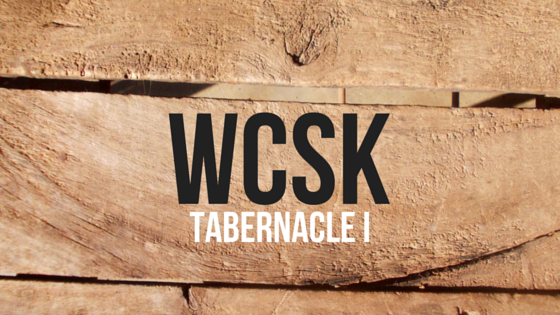Introduction
The tabernacle is the single subject that God devoted the most attention to in the entire Bible. So, the eternal God of the universe, the King of Kings and the Alpha and the Omega decided of all things He could speak about, He would spend the most time on the Tabernacle. The Tabernacle is discussed in Exodus chapters 25–40 and then again in Hebrews chapters 9–13.
Studying the tabernacle is so critically important because it describes how we, as a sinful people, can approach a Holy God. If you want to get closer to God and want to know how to approach Him, then you have to study the Tabernacle.
The Tabernacle is full of symbolism and typology and is a representation of Jesus. If you want to know more about Jesus or to be a better imitator of Him, then you have to study the tabernacle.
The Tabernacle was a replica of something perfect in Heaven.[1] It is a picture, or a type,[2] of Jesus, at the intersection of the unseen and the seen, at the intersection of God and humanity. The Tabernacle likely is the most intricate and detailed portrait of the Son of God (Christ) in the entire Old Testament and effectively illustrates God’s entire plan of salvation. The Tabernacle was always meant to point to something better.[3] The earthly Tabernacle consisted of members of the Levitical Priesthood. This order could only offer that which had been given and was limited to a natural lifespan. It was secondary and temporary. The new priesthood of Melchizedek[4] points to Jesus and is primary and permanent.
In essence, God wanted to dwell among His people (the Israelites); He wanted to fellowship with them and to communicate with them. Yet, a holy, just, and righteous God can’t just drop in and meet face to face with a sinful people—they had to make atonement for their sins and therefore be cleansed of their iniquity before being reconciled to a sinless God. In order for this to happen, the building had exact specifications set by The Lord. In Exodus 25:8 God says, “Let them construct a sanctuary for Me, that I may dwell among them” (italics mine). God’s motivation is clear: He wanted to be with His people and He wanted to have a relationship with them.
The Tabernacle was in the center of the Israelite camp. It was the place where God literally descended from Heaven in the form of a cloud by day and fire by night.[5] Not only was the Tabernacle a place where people met God, but it was the only place where a human being could approach God. And the only way to approach was by blood sacrifice: priests conducted animal sacrifices in order to temporarily atone for the sins of the people of Israel. The building itself was in operation for approximately 400 years from the time the Israelites wandered in the wilderness (1400–1500 BC) until the time that Solomon built the Temple (the fixed sanctuary) in Jerusalem.
The Tabernacle was a rectangular enclosure whose perimeter was decorated with curtains that hung on poles. The entire structure was 145 feet long, 72 feet wide and 7 feet high.[6] The Israelites moved about in the wilderness for 40 years, so whenever they moved to a new location, the Tabernacle was dismantled by the Levites (the priests) and then reconstructed at the destination.[7] While the Tabernacle was in one place, the twelve tribes of Israel camped around it in a defined order,[8] and the Levites were always in the immediate vicinity.[9]
In order to erect the tabernacle—a place suitable to receive God’s presence and be in His presence—the people had to give up things of tremendous earthly value. Hence, M. R. DeHaan writes:
“The most costly building, for its size, ever erected, was the tabernacle in the wilderness. Though only forty-five feet long, and fifteen feet wide, and having only two rooms, one the size of an ordinary living room, and the other the size of a bedroom, its cost is estimated to have exceeded two million dollars.”[10]
In fact, all the luxurious furnishings of the Tabernacle were provided by the Israelites.[11]
Back then, the Israelites communed with God through the Tabernacle. Now, we commune with God through Jesus. Then, God dwelt in the Tabernacle. Today, believers are God’s dwelling place,[12] His holy presence is among us,[13] those who believe God are part of a priesthood,[14] and the Tabernacle reveals to us an exact prescription of worship given by God to us.[15]
The Tabernacle was a place where God dwelled among His people, but Jesus is God incarnate who dwelled among us.[16] In fact, John 1:14 speaks of Jesus and says, “And the Word became flesh, and dwelt among us, and we saw His glory, glory as of the only begotten from the Father, full of grace and truth” (italics mine). The Greek word for dwelt is skenoo, which means to tent, encamp, reside or “tabernacle.”
The earthly Tabernacle is important because it tells us…
Drs. C. H. S. and C. H. E. Sadaphal
For Further Study
DeHann, M. R., The Tabernacle (Grand Rapids, MI: Zondervan, 1955).
Rose Publishing, Rose Guide to the Tabernacle with Clear Plastic Overlays and Reproducible Charts (Torrance, CA: Rose Publishing, 2008).
[1] Hebrews 8:4-5
[2] Hebrews 8:8-9
[3] Hebrews 9:11-14
[4] Genesis 14:18
[5] Exodus 40:38
[6] Paul Achtemeier, ed. et al., HarperCollins Bible Dictionary (SanFranciso: HarperSanFrancisco, 1985), 1087.
[7] Numbers 1:51
[8] Numbers 2:1-31
[9] Numbers 1:52-53
[10] DeHann, M.R., The Tabernacle (Grand Rapids, MI: Zondervan, 1955), 34.
[11] Exodus 25:1-9
[12] I Corinthians 6:19
[13] Exodus 40:34-38
[14] I Peter 2:5, 9
[15] Hebrews 10:19-25
[16] Exodus 25; Isaiah 9:6; Matthew 1:22-23; John 1:14; Hebrews 10:1
[17] Hebrews 9:11
[18] Exodus 28:1; 29:9; 30:10; Leviticus 16:30; Romans 3:21-26; 5:8-10; Hebrews 4:14-15; 8:1-3; 10:10-12.
[19] Romans 12:1
[20] Exodus 27:10-16; 38:14-19; John 10:9
[21] Exodus 27:9-18; 38:9-20; 40:33
[22] Exodus 27:1-8; 40:6, 10, 29; Leviticus 1
[23] c.f. Job 1:21
[24] Leviticus 4-6; Numbers 15:1-2
[25] Leviticus 4-6; Numbers 15:1-2
[26] Leviticus 2
[27] Exodus 12:37
[28] Hebrews 10:1-4, 11-14
[29] Exodus 27:1-8; 40:6, 10, 29; 30:17-21; 40:7, 30-32; Ephesians 5:26; Hebrews 10:22
[30] Exodus 25:31-40
[31] Exodus 25:23-30; Hebrews 9:2
[32] Exodus 30:1-37; Hebrews 9:2
[33] Exodus 26:31-33; Hebrews 10:19-20
[34] Exodus 26:33-34; Hebrews 9:3
[35] Exodus 25:10-16; Hebrews 9:4; c.f. John 6:44 & Ephesians 2:8-9
[36] Exodus 25:17-22; Hebrews 9:5
[37] Exodus 26:15-30; 27:9-19
[38] Hebrews 9:22
[39] I Corinthians 6:20
[40] I Peter 1:18-19
[41] Exodus 30:11-16
[42] Exodus 26:15-30; 27:9-19
[43] Judges 16:21; II Kings 25:7
[44] Revelation 19:8
[45] James 2:10
[46] Romans 8:3
[47] II Corinthians 5:17
[48] John 10:9
[49] Isaiah 53:2
[50] I Corinthians 2:14
[51] II Corinthians 4:4
[52] Exodus 38:18
[53] Matthew 2:2; 15:24; 27:42
[54] Mark 8:31; 10:33-34
[55] John 1:1-4, 14-18; 3:16-18
[56] Matthew 11:28
[57] Exodus 27:1-8
[58] John 10:1
[59] Proverbs 14:12
[60] Isaiah 53:7; John 3:16; Acts 2:23
[61] I Corinthians 15:3-4
[62] Acts 4:10-13
[63] Leviticus 6:12-13
[64] Leviticus 9:24
[65] Galatians 2:20
[66] Exodus 30:17-21; 38:8
[67] John 13:5-11
[68] James 1:23
[69] Titus 3:5
[70] For more on justification see WCSK Part V: Jesus Christ.
[71] II Corinthians 6:17

